In this answer it is said that the bulb in a Wien bridge oscillator is for temperature compensation.

Is that true? (I thought it is a kind of AGC to stabilize the output level.)
In this answer it is said that the bulb in a Wien bridge oscillator is for temperature compensation.

Is that true? (I thought it is a kind of AGC to stabilize the output level.)
An oscillator must have an "average" gain of exactly 1.000000 to produce stable oscillation. If the gain is anything below unity, the oscillations will decay to nothing. If the gain is anything above unity, the oscillations will grow until the oscillator can no longer manage unity gain (generally as a consequence of clipping parts of the signal). For an oscillator to produce a distortion-free output, the gain must be uniform throughout each oscillation cycle.
One approach to designing an oscillator is to make it produce slightly lower gain at higher amplitudes. If one has an oscillator circuit with a gain of 1.001 at voltages within the range -0.9 to +0.9, and 0.999 at values outside the range -1.1 to +1.1, then it will oscillate with an amplitude somewhere around a volt. Unfortunately, the variation in gain throughout each cycle will cause some distortion. One could reduce the distortion by reducing the variation in gain, but the circuit would become very "touchy"; even with the values given, something which reduces the gain of the circuit by 0.1% could cause it to stop oscillating altogether.
The idea of the light bulb is to have a circuit whose gain will be reduced as its output amplitude increases, and increased as its output amplitude decreases. The light bulb's delay in reacting to changes in amplitude, and the delay in the circuit's amplitude in response to gain mean the light bulb/gain circuit may oscillate at a few hertz, but one can design that "oscillator" so that its oscillations will decay toward nothingness.
When first powered up, the lamp is cold and has a low resistance. This makes the circuit gain greater than 1 and helps kick-start the oscillator. As the lamp warms, with bigger amplitudes, its resistance gets a bit bigger. This reduces the gain of the circuit and stabilizes the oscillator amplitude.
The lamp posseses a fair degree of thermal lag and for most frequencies above low audio it's resistance doesn't change much over a cycle of the oscillator waveform and hence the signal isn't distorted much.
When the frequency gets low (10Hz or less typically) there is noticeable distortion on the top of the waveform compared to the bottom because, the bottom of the waveform generates less heat and at low frequencies the bulb cools down more compared to the top of the waveform when more heat is generated.
Modern Wien oscillators use a JFET for amplitude control by converting the peak amplitude of the output to a DC level (rectification and smoothing) but they still suffer from low frequency distortion because at low frequencies there will be a pronounced ripple on the DC level controlling the amplitude via the JFET.
The lamp is a resistor with a positive temperature coefficient, which means it's resistance increases as it gets warmer. The lamp is actually 'powered' by the output of the oscillator, so the larger the amplitude of the oscillation the warmer the lamp gets and the greater it's resistance becomes. Notice that the lamp is in the negative feedback path of the oscillator, so the more resistance it has the lower the gain of the oscillator. So Rf, the negative feedback resistor, must be selected such that the total loop gain is precisely 1 when the oscillator's output amplitude is at the desired level. SO IT IS AGC JUST AS YOU THOUGHT.
The bulb is a cheapass/very old fashioned PTC of sorts. I don't think this is ever used anymore to be honest. Googling around I see a couple of people using it for novelty projects, but if you are really interested in building such an oscillator (which is still fundamentally unstable in some modes) you'd just use an actual PTC nowadays.